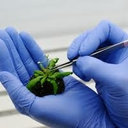Phytochemical Screening, Alpha-Glucosidase Inhibition, Antibacterial and Antioxidant Potential of Ajuga bracteosa Extracts.
Ključne riječi
Sažetak
BACKGROUND
Ajuga bracteosa, a medicinal herb, is used by local community to cure a number of diseases such as inflammation, jaundice bronchial asthma, cancer and diabetes.
OBJECTIVE
The aim of present work was to evaluate the antioxidant potential, in vitro antidiabetic and antimicrobial effects of A. bracteosa.
METHODS
n-hexane, ethyl acetate, chloroform, acetone, methanol and aqueous extracts of Ajuga bracteosa roots, were prepared via maceration. Antibacterial activity was carried out by agar well diffusion method. Quantitative and qualitative phytochemical screening was done. The antioxidant activity was determined by iron (II) chelating activity, iron reducing power, DPPH, and ABTS free radical scavenging methods, Antidiabetic activity was evaluated through inhibition of α-glucosidase assay.
RESULTS
Phytochemical analysis showed the presence of phenols, flavonoids, tannins, saponins, quinines, terpenoids, xanthoproteins, glycosides, carbohydrates, steroids, phytosterols and amino acids. DPPH and ABTS potential values were recorded as 61.92% to 88.84% and 0.11% to 38.82%, respectively. Total phenolic and total flavonoid contents were expressed as gallic acid and rutin equivalents. Total iron content was expressed as FeSO4 equivalents. Chloroform and n-hexane extracts showed significant enzyme inhibition potential with IC50 values of 29.92 μg/ml and 131.7 μg/ml respectively. Aqueous extract showed maximum inhibition of E. coli, S. typhimurium, E. amnigenus, S. pyogenes, and S. aureus, (18.0±1.0 mm, 12.5±0.7 mm, 17.0±0.0 mm, 11.0±0.0 mm and 15.3±2.0 mm mm), respectively. Similarly, n-hexane extract showed maximum inhibition of E. coli, E. amnigenus, S. aureus (11.6±1.5 mm; 11.3±1.5 mm; 13.3±0.5 mm). This study also shows that n-hexane, chloroform, ethyl acetate and aqueous extracts of A. bracteosa root possess α-glucosidase inhibitory activities and therefore it may be used as hypoglycemic agents in the management of postprandial hyperglycemia.
CONCLUSIONS
Ajuga bracteosa root extracts may provide a basis for development of antioxidant, antimicrobial and antidiabetic drugs.


